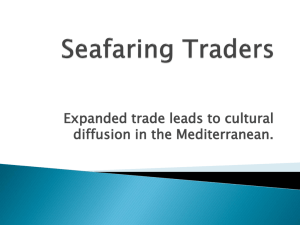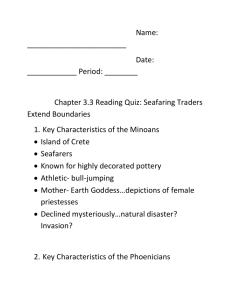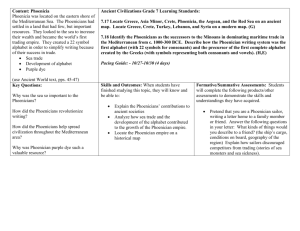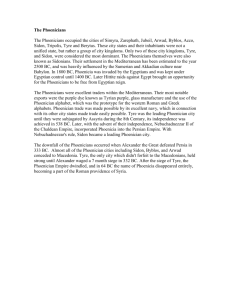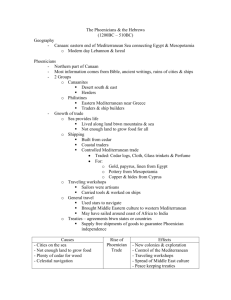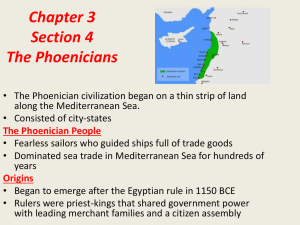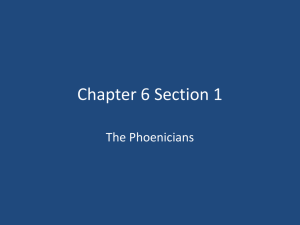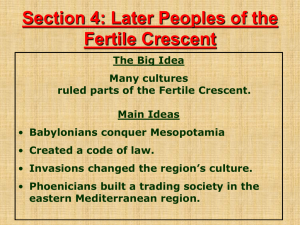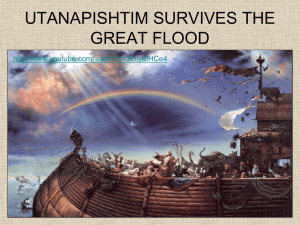Seafaring Traders - New Haven School
advertisement
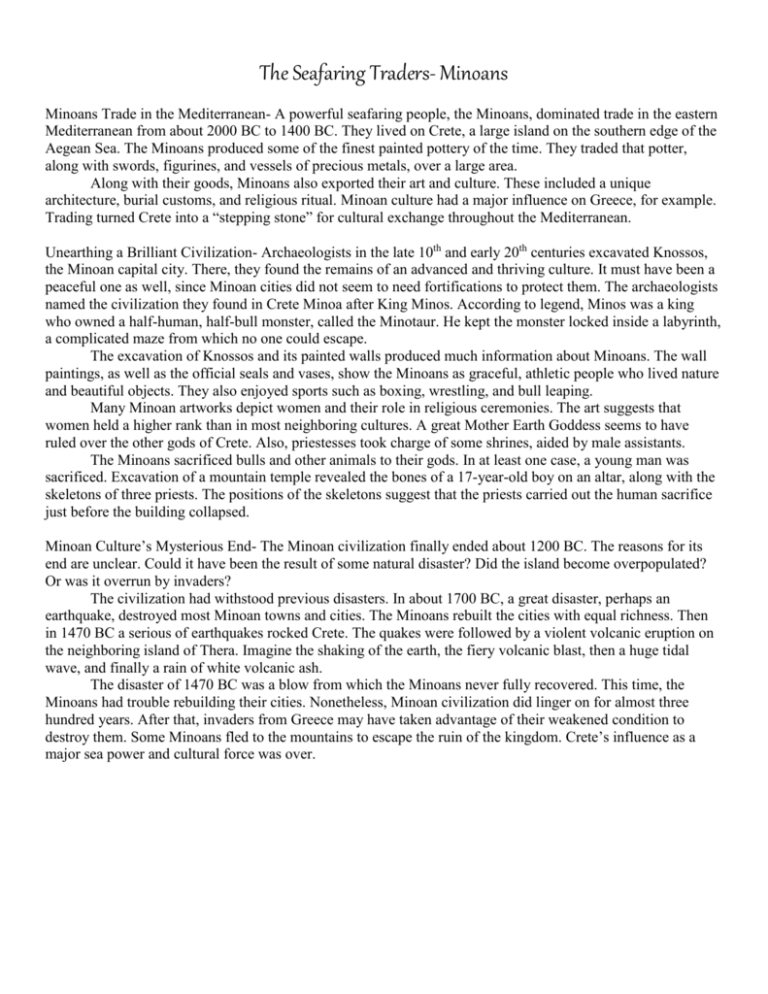
The Seafaring Traders- Minoans Minoans Trade in the Mediterranean- A powerful seafaring people, the Minoans, dominated trade in the eastern Mediterranean from about 2000 BC to 1400 BC. They lived on Crete, a large island on the southern edge of the Aegean Sea. The Minoans produced some of the finest painted pottery of the time. They traded that potter, along with swords, figurines, and vessels of precious metals, over a large area. Along with their goods, Minoans also exported their art and culture. These included a unique architecture, burial customs, and religious ritual. Minoan culture had a major influence on Greece, for example. Trading turned Crete into a “stepping stone” for cultural exchange throughout the Mediterranean. Unearthing a Brilliant Civilization- Archaeologists in the late 10th and early 20th centuries excavated Knossos, the Minoan capital city. There, they found the remains of an advanced and thriving culture. It must have been a peaceful one as well, since Minoan cities did not seem to need fortifications to protect them. The archaeologists named the civilization they found in Crete Minoa after King Minos. According to legend, Minos was a king who owned a half-human, half-bull monster, called the Minotaur. He kept the monster locked inside a labyrinth, a complicated maze from which no one could escape. The excavation of Knossos and its painted walls produced much information about Minoans. The wall paintings, as well as the official seals and vases, show the Minoans as graceful, athletic people who lived nature and beautiful objects. They also enjoyed sports such as boxing, wrestling, and bull leaping. Many Minoan artworks depict women and their role in religious ceremonies. The art suggests that women held a higher rank than in most neighboring cultures. A great Mother Earth Goddess seems to have ruled over the other gods of Crete. Also, priestesses took charge of some shrines, aided by male assistants. The Minoans sacrificed bulls and other animals to their gods. In at least one case, a young man was sacrificed. Excavation of a mountain temple revealed the bones of a 17-year-old boy on an altar, along with the skeletons of three priests. The positions of the skeletons suggest that the priests carried out the human sacrifice just before the building collapsed. Minoan Culture’s Mysterious End- The Minoan civilization finally ended about 1200 BC. The reasons for its end are unclear. Could it have been the result of some natural disaster? Did the island become overpopulated? Or was it overrun by invaders? The civilization had withstood previous disasters. In about 1700 BC, a great disaster, perhaps an earthquake, destroyed most Minoan towns and cities. The Minoans rebuilt the cities with equal richness. Then in 1470 BC a serious of earthquakes rocked Crete. The quakes were followed by a violent volcanic eruption on the neighboring island of Thera. Imagine the shaking of the earth, the fiery volcanic blast, then a huge tidal wave, and finally a rain of white volcanic ash. The disaster of 1470 BC was a blow from which the Minoans never fully recovered. This time, the Minoans had trouble rebuilding their cities. Nonetheless, Minoan civilization did linger on for almost three hundred years. After that, invaders from Greece may have taken advantage of their weakened condition to destroy them. Some Minoans fled to the mountains to escape the ruin of the kingdom. Crete’s influence as a major sea power and cultural force was over. The Seafaring Traders- Phoenicians Phoenicians Spread Trade and Civilization- About 1100 BC, after Crete’s decline, the most powerful traders along the Mediterranean were the Phoenicians. Phoenicia was mainly the area now known as Lebanon. Phoenicians never united into a country. Instead, they founded a number of wealthy city-states around the Mediterranean that sometimes competed with one another. The first cities in Phoenicia, such as Byblos, Tyre, and Sidon, were important trading centers. The Phoenicians were remarkable shipbuilders and seafarers. They were the first Mediterranean people to venture beyond the Strait of Gibraltar. Some scholars believe that the Phoenicians traded for tin with the inhabitants of the southern coast of Britain. Some evidence exists for an even more remarkable feat- sailing around the continent of Africa by way of the Red Sea and back through the Strait of Gibraltar. Such a trip was not repeated again for 2,000 years. Commercial Outposts Around the Mediterranean- The Phoenicians’ most important city-states in the eastern Mediterranean were Sidon and Tyre, both known for their production of red-purple dye, and Byblos, a trading center for papyrus. Phoenicians built colonies along the northern coast of Africa and the coasts of Sicily, Sardinia, and Spain. The colonies were about 30 miles apart- about eh distance a Phoenician ship could sail in a day. The greatest Phoenician colony was at Carthage in North Africa. Settlers from Tyre founded Carthage in about 814 BC The Phoenicians traded goods they got form other lands- wine, weapons, precious metals, ivory, and slaves. They were also known as superb craftspeople who worked in metal, wood, glass, and ivory. Their redpurple dye was produced from the murex, a kind of snail that lived in the waters of Sidon and Tyre. One snail, when left to rot, produced just a drop or two of a liquid of a deep red-purple color. Some 60,000 snails were needed to produce one pound of dye, which only royalty could afford. Phoenicia’s Great Legacy- The Alphabet- As merchants, the Phoenicians needed a way of recoding transactions clearly and quickly. So the Phoenicians developed a writing system that used symbols to represent sounds. The Phoenician system was phonetic- that is one sign was used for one sound. In fact, the word alphabet comes directly from the first two letters of the Phoenician alphabet: aleph and beth. As they traveled around the Mediterranean, the Phoenicians introduced this writing system to their trading partners. The Greeks, for example, adopted the Phoenician alphabet and changed the form of some of the letters. Few examples of Phoenician writing exist. Most writings were on papyrus, which crumpled over time. However, the Phoenician contribution to the world was enormous. With a simplified alphabet, learning was no accessible to more people. Phoenician trade was upset when their eastern cities were captured by Assyrians in 842 BC. However, these defeats encouraged exiles to set up city-states like Carthage to the west. The Phoenician homeland later came under the control of the Babylonians and of the Persian empire of King Cyrus I. One of their most lasting contributions remains the spread of the alphabet. Ancient Trade Routes- Trading in ancient times also connected the Mediterranean Sea with other centers of world commerce, such as South and East Asia. Several land routes crossed Central Asia and connected to India through Afghanistan. Two sea routes began by crossing the Arabian Sea to ports on the Persian Gulf and the Red Sea. From there, traders either went overland to Egypt, Syria, and Mediterranean countries, or they continued to sail up the Red Sea. To cross the Arabian Sea, sailors learned to make sue of the monsoon winds. These winds blow from the southwest during the hot months and from the northeast during the cool season. To widen the variety of their exports, Indian traders used other monsoon winds to Southeast Asia and Indonesia. Once there, they obtained spices and other products not native to India. Though traveling was difficult in ancient times, trading networks like those of the Phoenicians ensured the exchange of products and information. Along with their goods, traders carried ideas, religious beliefs, art, and ways of living. They helped with the process of cultural diffusion as well as with moving merchandise.
